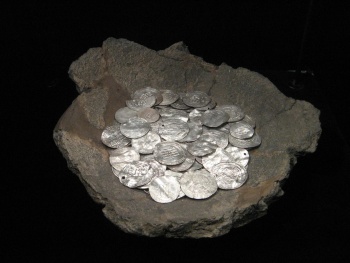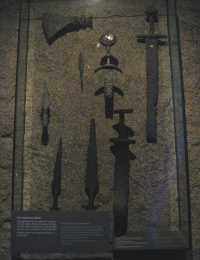Ellie Cormack • foto: Ivana Herglová • 10 April 2018
Life and Biography in the Middle Ages: A Heathen King
The speaker at one of the literary lecture offered in the series 'Life and Biography in the Middle Ages' on the topic of 'A Heathen King' at the Faculty of Arts on the 29th of March was Dr. Rolf Stavnem, who lectures on Nordic medieval literature and languages at the Aarhus University in Denmark.
A glance over the handout provided at the start of the session with extracts of various old Nordic texts made the recurring theme of the lecture become immediately clear – lines such as 'Hogni laughed as they cut out his heart', 'It was that gave that gramr his death' and 'Dagr, I heard, death's judgment' certainly signaled the tone of the lecture. Jokingly, Stavnem commented that the lecture for the week may more aptly have been titled 'Death and Biography' and later referred to one ancient King in particular with the simple note that their life was presumably “so uneventful that we know nothing of them but how they died”.

The collection of extracts compiled by Stavnem began with Historia Norvegiae, a history of Norway written in roughly 1200, in which the author describes how the Kings of old were 'worshipped as gods by their posterity' before going on, in what seems like somewhat of a contradiction, to say nothing of the lives of these Kings, but rather to describe – in a rather matter-of-fact way – the manner in which they died: King Domaldi of Uppsala was hanged by the Swedes as a sacrifice to the goddess Ceres, Ingjaldr, another legendary ruler of early medieval Sweden, was killed in an act of fratricide, and their predecessor on the Swedish throne, Vanlandi, was smothered by a demon in his sleep. In fact, the only King mentioned in the text who was not killed in a rather bizarre and epic fashion was Aun, who died in 'the drawn-out infirmity of old age', which the author seemed to be fairly displeased with, mentioning that he could not eat, but instead rather pathetically only sucked milk from a horn 'like an infant' for his last 9 years of life, suggesting that perhaps an epic death would have been preferable for the sake of his legacy.
Stavnem explained that for example the text 'Hogni laughed/ as they cut out his heart/ the warrior still alive/ never thought of whining', from the poem Ynglingatal, was a more typical picture of the deaths presented in these old Norse texts: it describes a classic heroic situation, with someone captured and then threatened and ultimately staring into the face of death without showing fear. This bravery is (for the reader at least!), seemingly a more satisfactory end, and provides the King with a more worthy story to be remembered by than his life itself.
Stavnem also made reference to an image painted by Carl Larsson in the early 20th century and named 'Midvinterblot' (Swedish for ‘Midwinter sacrifice’), which can be found at the National Museum in Stockholm, and in which the stabbed victim is the mystical King Domaldi. This story was taken from the famous Old Norse prose Edda written in Iceland by Snorre Sturlasson early in the 13th century. Asides from this poem, there is no evidence the King actually existed. If you are ever in Stockholm, check it out!
 One of the other texts discussed included an extract from Ynglinga Saga, which is a legendary saga originally written in Old Norse by the aforementioned Icelandic poet Sturlasson in about the year 1225, and a poem, which Sturlasson claimed to have cited in his work that mentions twenty-seven Norse Kings, along with details about their deaths and even some of their burial places. As Stavnem pointed out, it is hard to know to what extent these texts have truth to them and how historically accurate they are. In fact, Stavnem made the particularly interesting comment that the quoted poem was supposedly sung orally for roughly 300 years before ever having being officially written down and captured in writing – though he himself posed the question of whether this was truly possible!
One of the other texts discussed included an extract from Ynglinga Saga, which is a legendary saga originally written in Old Norse by the aforementioned Icelandic poet Sturlasson in about the year 1225, and a poem, which Sturlasson claimed to have cited in his work that mentions twenty-seven Norse Kings, along with details about their deaths and even some of their burial places. As Stavnem pointed out, it is hard to know to what extent these texts have truth to them and how historically accurate they are. In fact, Stavnem made the particularly interesting comment that the quoted poem was supposedly sung orally for roughly 300 years before ever having being officially written down and captured in writing – though he himself posed the question of whether this was truly possible!
‘Ynglingatal is written in the style of kviðuháttr' , which means that the lines alternate between only three and four syllables, and contain a number of metaphors and 'kennings' – which are often seen in the old Norse poetry, Stavnem explained, and which are like condensed metaphors in which an object is referred to using a compound, such as 'blood-ember' to mean 'axe'. Typical of old Norse writings, both this poem and the other texts also contain a fairly pragmatic list of events rather than a huge amount of description, for example: 'Then King Olafr had him taken away and his head cut off' – straight to the point, no flowery language there! Typical of such texts, there is also a harmony between the prose and verse, as the texts being discussed often slip between both forms.
Near the end of the session, Stavnem questioned whether these texts ought to be called literature at all, because they were produced on the back of eye-witness accounts and not generated by the author's imagination; yet, as the texts contain the conventions expected of literature, he argues, to attempt to understand these texts without understanding these conventions and patterns would be useless – and the main pattern in these texts, which needs to be understood in more detail, it seems, is the bizarre deaths they describe and the significance of this in representing the lives these Kings had lived.
